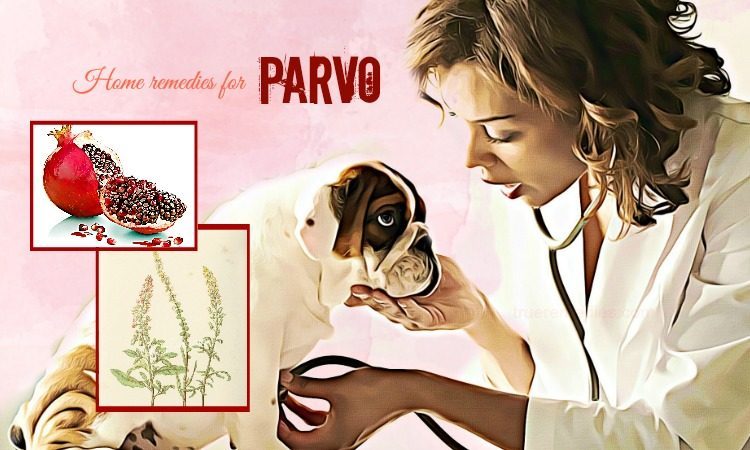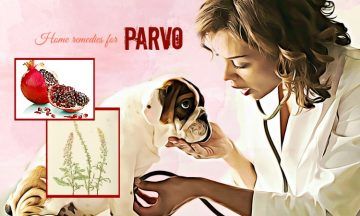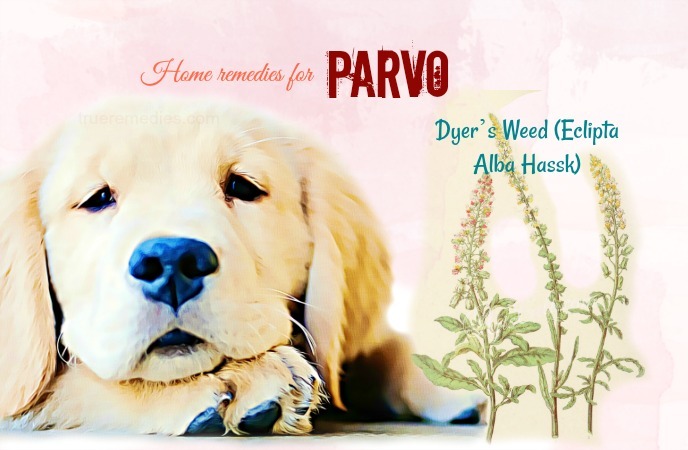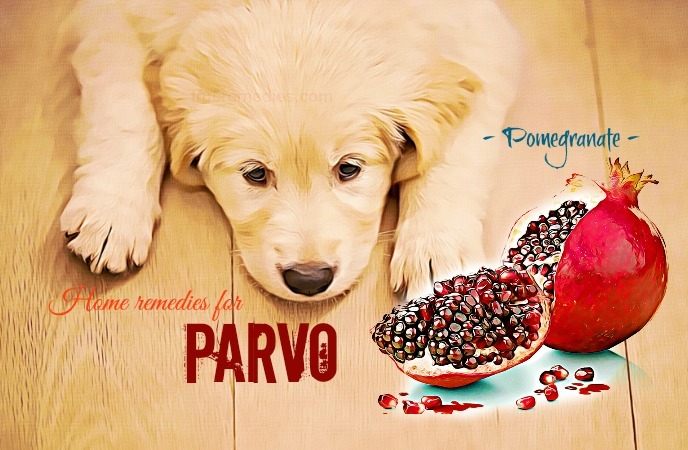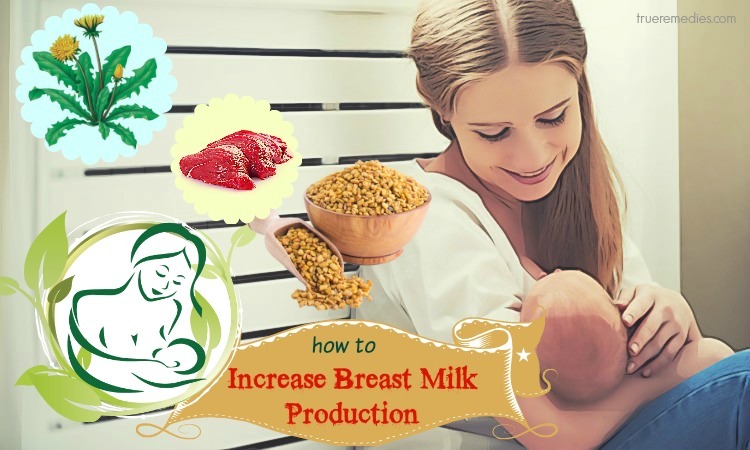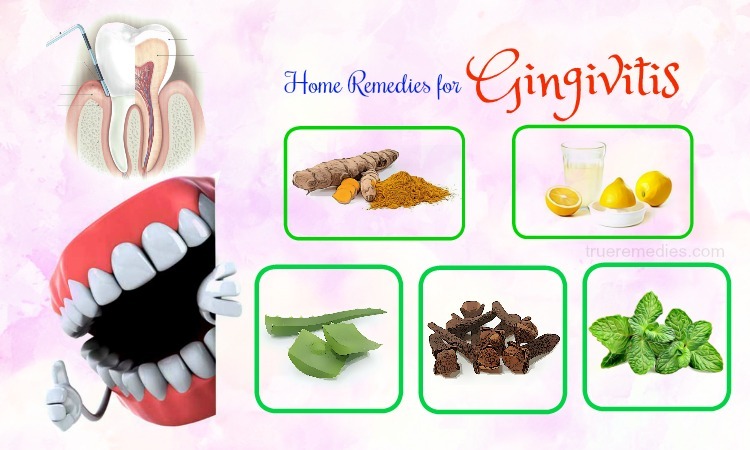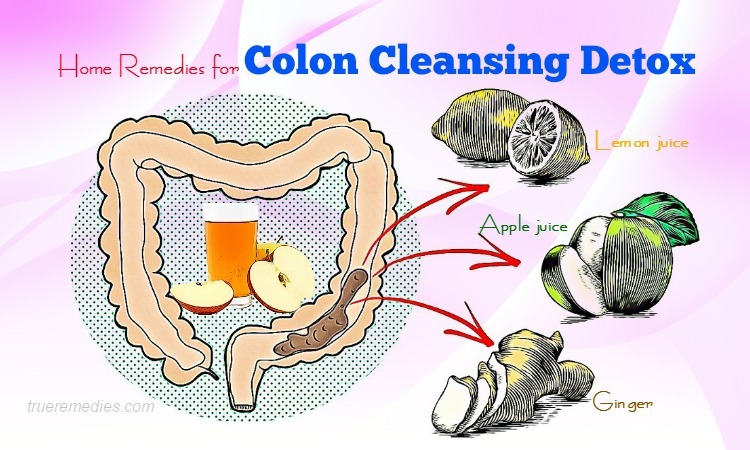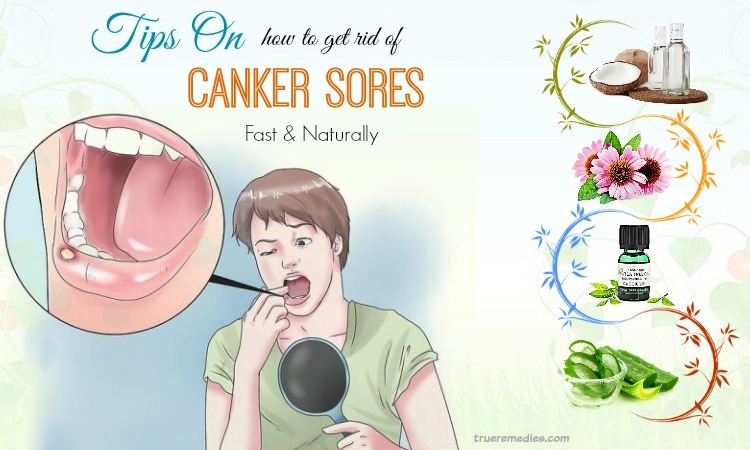CONTENTS
Puppies that are nearly 2 months old should be vaccinated to prevent 6 diseases. Some dog owners do not have time or they think their dogs are still healthy, so they are subjective in the prevention of pets. This makes their dogs at high risk of some diseases, especially parvo. Parvo can cause vomiting and diarrhea in dogs and it is one of the most dangerous infectious diseases in dogs.
Dogs that survive after infected by this disease may suffer from sequelae like chronic diarrhea and heart disease. The virus attacks very fast in the tissues, so puppies less than 6 months old are very susceptible. It occurs through contact with infected stools, so it is a common problem in pet stores. Parvo is a very common, rapidly spreading, and highly pathogenic predisposition to dogs under one year old especially dogs not vaccinated with vaccines.
Parvo occurs severely with the majority of puppies, but canine dogs may also be affected. Early intervention can still be treated, if left untreated, with over 80% mortality from parvo. Dog owners are not knowledgeable about Pavo disease so that their dogs are too late to be treated, the disease is fast and the dog usually dies 48-72 hours after the first symptoms.
Are you worried about how to prevent or treat parvo for your dogs? Don’t worry, the following article will help you. This article will give you the natural home remedies for parvo in dog. They are all very safe, simple and effective.
However, before that, let’s learn some basic information about this disease to get the best view on it and also determine the condition of your dog to have the most appropriate treatment.
What Is Parvo In Dog?
Parvo disease is a dangerous infectious disease that spreads rapidly and kills many dogs, especially young ones. This is a serious gastroenteritis caused by Canine parvovirus (CPV). The virus affects the digestive tract in dogs and is transmitted when the dog is in direct contact with healthy dogs or germs in feces, the environment, or humans. Viruses can infect in cages, food, and water, neck, ligaments, or hands and clothing of people who come into contact with sick dogs. Under normal conditions, the virus is stable with hot and cold temperatures, high humidity or dryness, and is likely to survive in the environment for long periods of time. Infected dogs in their feces for about 2 weeks after infection, the virus can survive in the environment for many years. Viruses can still be transmitted from one place to another via the hair or dog's feet when they come into contact with cages, shoes or other items containing the virus [1].
TrueRemedies Partner Solutions

Need a Help from the Leading Expert Online, Available 24/7?
They’re all here and ready to answer your questions online or by phone. Keep asking questions until you get the answer you need.
Duration of disease (from exposure to the virus to disease development) is 2-14 days.If your dog is parvovirus, give it to the vet immediately to increase the survival rate. However, do not be confused because the symptoms of Parvo are very similar to those of other dog diseases such as Corona infection, bacterial hemorrhagic septicemia, and parasitic hookworms.
What Are Common Causes Of Parvo In Dog?
The cause of Parvo is a virus called Canine parvovirus (CPV) which is first discovered in 1978. In the past few years, Parvovirus has mutated into two different strains and has evidence of a third strain in Italy, West Spain, and Vietnam. Currently, the most common worldwide disease is CPV-2b. Through research, scientists have determined that the majority of Parvo-infected dogs are caused by two strains: CPV-2a and CPV-2b. In Italy, Spain, and Vietnam, the third virus, CPV-2c, also causes parvo. This is a highly contagious disease, quickly spreading and killing many dogs, especially young dogs and dogs with weak immune systems. This powerful virus is accompanied by extensive infection, wide heat tolerance and high immunity to many types of detergents. They can survive in the sun's natural environment for up to 5 months, shadows 7 months and maybe even longer.
Note that all breeds of dog may be affected by the disease; however, because of the breed characteristics, some breeds are more prone to parvo infection than others, such as Clam breeds, Pinschers breeds…
How To Distinguish Types Of Parvo In Dog?
- Myocarditis
Infected heart specimens are usually found in infected dogs or puppies right after birth. This disease is very less common than the intestinal tract. The disease is very severe, causing inflammation and cardiac necrosis, which causes shortness of breath and premature death (<8 weeks). Puppies survive scarring in the heart muscle. The disease may or may not be accompanied by signs and symptoms of the intestinal tract. However, this type is now rarely seen in the world. This disease is common in 4 to 8 weeks old dogs with signs of shortness of breath, moaning. Dogs die after a few hours or minutes, or sudden death from heart failure.
- Intestinal Tract (3-5 Days)
The virus divides into intestinal epithelial cells causing necrosis of the mucosal cells, causing diarrhea – hemorrhage. Mucus membranes usually break apart and combine with other substances to produce an unpleasant odor. This can provide an opportunity for secondary infections when intestinal bacteria – such as Salmonella, C.perfringens, E. coli, Campylobacter, Coronavirus and other parasites can enter the bloodstream more Mucosal areas are peeling. In addition, it triggers a serious secondary infection.
Dogs often have severe diarrhea symptoms that cause dehydration, electrolysis, blood and secondary infections. The Parvovirus also attacks the gastrointestinal tract, causing the animal to lose its ability to absorb nutrients and fluids. Dogs are moody, quit eating, vomiting, new stools are yellowed and then gray/red with blood, stools have a characteristic smell, some dogs show fever / some children.
Animals exhibit atheism, rapid weight loss, abdominal pain, shock due to blood loss … Dogs will not die from the virus but die from secondary infection after 2-5 days.
- Combination Disease
This is the fastest way for the death of a dog. It is caused by the combination of symptoms of both diseases above.
How To Prevent Parvo In Dog Disease?
To prevent parvo in dogs, follow the immunization schedule and clean the dog's area.
Puppies are more susceptible to infection because the natural antibodies in breast milk may not be sufficient to protect until the puppy's immune system is strong enough to fight the disease or the vaccine is neutralized by the antibody of the mother dog. Therefore, the owner should follow the veterinarian's vaccination schedule to best protect the animals.
Until the puppy completes the first vaccination schedule, the owner should pay attention when walking the dog to the park, dog training, pet stores, and hotel services for dogs.
It is recommended to vaccinate at least one month before the mother is pregnant to provide natural immunization for puppies after birth.
Care, Nutrition And Disease-Enhancing Science Of Dogs.
Unvaccinated dogs should not be exposed to sick dogs. Persons who have contact with sick dogs should not contact other dogs. If contact, persons should wash hands (and disinfect or change clothes) before contact.
Despite the vaccination, a few dogs do not produce protective antibodies, so they are more susceptible to infection.
Never let your dog touch (sniff, lick, etc.) with other dog excrements on the street, park, playground, etc. Clean your pet's stool to avoid spreading parvovirus as well as other illnesses that can cause affects humans and animals.
If the dog shows signs of vomiting or diarrhea or has ever been exposed to a sick dog, the owner should not bring the dog to the park, dog beauty salon, dog hotel, park … to avoid spreading the virus to other dogs.
Note that:
Vaccination is the only way to keep your dogs from parvo. The first injection should be done when the dog is 5 to 6 weeks old, then every 2 to 3 weeks execute an injection and keep doing for at least 3 shots.
Parvo is a persistent virus, not easily decomposed. The virus is resistant to many types of biocides and can last for many months, even more. The important thing to do is to ensure cleanliness and sterilization for dogs. Look for products labeled as parvo or bleach remedies safely by a partial detergent, 30 parts water.
Parvo is a viral disease that cannot be treated with antibiotics.
What Are Common Symptoms Of Parvo In Dog?
When the Parvo Virus enters the animal's body, there are usually no clinical symptoms. In general, it takes 3 to 10 days after the virus enters the body, new dogs begin to show symptoms of the disease. The virus causes inflammation of the entire gastrointestinal tract, dehydration, and severe electrolyte disturbances. Dogs collapse rapidly due to blood loss, anemia, hypoproteinemia, endotoxemia caused by endotoxemia toxicity, the decline of white blood cells. Dogs die quickly due to shock, circulation, respiration.
Effective treatment is very low, especially for puppies because they are stressed by the environment, intestinal parasite infection, often followed by other bacterial diseases cause severe gastrointestinal inflammation.
As a result, there are some symptoms of parvo in dog:
- Dog Behavior
In general, the first manifestation of parvo-infected dogs is lethargic. Your puppy may be less active, lying in a corner and not moving. Then show weakness and loss of appetite.
- The Dog Has A Fever
Parvo dogs are prone to fever at a temperature of 40 to 41ºC
- Vomiting
Parvo destroys the stomach that contains many rapidly dividing cells. This is the goal of the virus. The gastric mucosa will be swollen and ulcer causing the dog to vomit.
- Dog Excrement Is Unusual
If your dog has diarrhea, loose stools, mucus, bloody stools or irregular shapes, it is very likely that the dog has Parvo. It can also cause dehydration.
- Anemia
Parvo causes gastrointestinal hemorrhage resulting in anemia. To check if your dog is anemic, press the dog's gingiva. The gingiva color of a healthy dog quickly returns to normal color after about 2 seconds. For longer, your dog may have diarrhea. The gingiva of these dogs often looks pale.
Who Is Risk Of Parvo In Dog?
The followings are factors affecting the risks of dogs for parvo infection and should be taken into consideration:
- Consider Age Of Dog
Parvo usually develops in puppies from 6 to 20 weeks of age and 85% of infections occur from puppies under 1 year of age. Puppies are most susceptible to infection because they have a large number of rapidly dividing cells in the stomach and intestines. These cells are the primary target of the Parvo virus. If your dog is older, Parvo will be more difficult to effect even if it is not impossible. If the dog mother does not have the Parvo vaccine, it is likely that the virus will break out sooner in the first few weeks of puppies.
- Dog Breed
Parvo disease usually spreads in certain breeds such as American Pitbull, Doberman Pinscher, and German shepherd dog. If your dog is part of one of these breeds, you must pay special attention to whether it has Parvo.
When To See A Doctor?
You should contact veterinarian immediately if your dog have one of these symptoms above. Do not try to treat Parvo yourself. Although the dog is carefully guarded by a veterinarian, the virus can still be life-threatening. Trying to treat dogs is a very risky way.
There, you have discovered some information about parvo in dog. To overcome this condition, many people come to see a veterinarian. However, if you want to prevent this disease, or your dog condition is not too severe, you can fully apply the home remedies we will mention below. With these home remedies, you can do them at home. This is not time consuming but very effective. It is time to find out what the best home remedies for parvo in dog are. Take a look at TrueRemedies.com!
Top 10 Natural Home Remedies For Parvo In Dog
1. Dyer’s Weed (Eclipta Alba Hassk)
This is the first worth-trying suggestion in list of top 10 natural home remedies for parvo in dog.
Chemical composition of dyer’s weed: essential oils, tannins, bitter substances, carotene, and alkaloids which is called the ecliptin. There are documents says that Dyer's Weed contain the substance wedelolactone (a substance called curmarin lactone)which separates demetylwedelactone and a flavonozide.
Dyer's Weed is similar to vitamin K, which acts against the effect of discumarin, preventing uterine bleeding in laboratory animals. Dyer's Weed does not cause hypertension, vasodilatation, and non-toxic. Dyer's Weed contains tannin that can shorten blood clotting time. It is capable of inhibiting the growth of cancer cells, especially in stomach cancer. It also activates the immune system, which is powerful for T-lymphocytes (T lymphocytes).
Using Dyer's Weed as a treatment is very effective for parvo in dog because parvo in dog causes bleeding in the intestines:
What you need to do is:
- Prepare 40 grams of Dyer's Weed, 1/2 teaspoon salt.
- Rinse Dyer's Weed and soak in salted water for 30 minutes.
- Put the Dyer's Weed into the grinder to grind totally.
- Squeeze the juice and remove the residue.
Adjust the condition of your puppies to give the dosage accordingly. The recommended dosage is 2-3 times a day, each time is about 3 ml of Dyer's Weed juice.
2. Mangosteen Shell
Among home remedies for parvo in dog, using mangosteen shell is one of the most effective. Mangosteen, Garcinia mangostana L, belongs to the family Clusiaceae. The mangosteen fruit is collected in the ripe fruit season [2].
Chemical composition: Mangosteen shell contains 7-13% tannin, resin and mangosteen bitter substance with small yellow crystals insoluble in water. The tree also contains tannins. These tannins have a good hemostatic effect in the intestine, so mangosteen shell is effective in treating parvo in dogs.
Method 1: Home Remedies For Parvo Using Only Mangosteen Shell
To implement this method, follow these instructions:
- Prepare about ten mangosteen shells.
- Bring the mangosteen peel into an airtight pressure cooker.
- Boil until water is dark, let cool water and feed your puppy twice a day, 100ml each morning and evening.
Method 2: Mangosteen Shell And Green Tea
To implement this method, follow these steps:
- Prepare 2-3 shells of mangosteens, 3-4 green tea leaves.
- Put the mixture on the grinder to grind totally.
- Squeeze the juice and feed your puppy.
Note: Do not use this method too many times, it should only be used once.
3. Seawater
This is another must try home remedy in list top 10 natural home remedies for parvo in dog. Dogs die from lack of water, lack of nutrients to feed the body, so the best way to treat a parvo sick dog is to add water and essential nutrients. However, when the dog is vomiting too much, you should not give the dog too much water because when drinking water will irritate the stomach and cause more vomiting.
Excessive vomiting can lead to bowel rupture. To implement this remedy, you only need to let your dog to have an intravenous drip. This is necessary for you to do this remedy gradually, each time 100ml of seawater.
4. Digestive Enzymes And Oresol
If your dog is afraid of pain and does not consent to the transmission of seawater into the body. You can use this remedy as a treatment of parvo in dog.
Digestive enzymes and oresol can be purchased at over-the-counter and daily-use pharmacies. This is a way to add water as well as electrolytes to the dog body. It helps to restore and enhance resistance to dog parvovirus [3].
To implement this method, follow these steps below:
- Prepare a packet of enzyme and half a pack of oresol.
- Mix the above into about 6 ml of cold water. Hot water will make enzymes lose effect.
- Give your dog drink them each 2 hours, 3ml each time.
- If your dog does not want to drink, use a needle to pump it into his mouth.
5. Glucose
Glucose is a 6-carbon sugar, administered orally or intravenously to treat glucose and fluid shortages. Glucose is often used to provide energy by injection for patients and is used along with electrolyte solutions to prevent and treat dehydration caused by acute diarrhea. Glucose is also used to treat hypoglycemia.
Effects of glucose:
- Provides water and energy for the body.
- Detoxification in case of acute and chronic infections, narcotic effects, cyanide poisoning or carbon dioxide; shock and collapse, hepatitis or cirrhosis.
- Nutritional support for the body in case of blood loss, dehydration due to diarrhea, vomiting.
- Transfusions to infuse drugs before, during and after surgery.
- Prevention and treatment of blood ketones in malnutrition cases.
- Used for hypoglycemia.
Therefore, using glucose as a treatment of parvo in dog will help your dog have strength to fight against parvovirus.
To implement this remedy, please follow these steps below:
- Prepare 10 ml of glucose water.
- Feed your dog gradually with the syringe for 4-5 times a day, each times 2 hours apart.
6. Pomegranate
The next home remedy in list top 10 natural home remedies for parvo in dog is pomegranate. Pomegranate reduces inflammation and inflammation, reduces high blood pressure. It also acts as a natural aspirin, improving blood flow in the body. In addition, pomegranates have the potential to increase the production of enzymes that support digestion. It also helps relieve urinary tract infections and regulates bowel movements. Therefore, the use of pomegranate as a treatment of parvo in dog is very effective.
To implement this remedy, follow these guidelines below:
- Prepare 30 grams of pomegranate, 1 tablespoon of glucose.
- Put pomegranate in the blender to grind totally.
- Take the juice of the pomegranate and add the glucose then stir well.
- Use the mixture on your dog for a day, divided into several times.
7. Apple
Using apple is a very beneficial treatment in this list of natural home remedies for parvo in dog. Apples contain more pectin than any other fruits. This substance is decomposed in the intestine by good bacteria, forming a protective gastric mucosa, helping to remove and prevent irritants to the intestines.
To implement this remedy, you only need to feed your dog some apple juice as a treatment of parvo in dog.
8. Banana
This remedy is one of little – known home remedies for parvo in dog.In bananas containing large amounts of potassium can provide electrolytes that the body is lacking. Pectin is a soluble fiber that can absorb excess fluid in the stomach during diarrhea. Another type of fiber, inulin, also found in bananas in large quantities is a probiotic, which helps to restore beneficial bacteria to the intestines.
Therefore, use banana as a treatment of parvo will help your dog recover quickly. The way to implement this remedy is very simple, you only need to feed your dog a little banana or feed your dog some banana juice.
9. Leaves Of Guava
This is another must – try in this list of home remedy for parvo in dog. Guava leaves contain very high tannin content. It can be used when dogs have diarrhea.
To implement this remedy, take the following steps:
- Prepare 20 grams of young guava leaf, 100 ml of water.
- Boil young guava leaves with water.
- Let it cool and let your dog drink it.
- Divide in 2 times and drink in 1 day.
10. Blueberries
Blueberries have properties that reduce inflammation in the stomach and bind cells in the intestinal wall, limiting secretions to mucus and fluid. It is also a good source of soluble fiber and mildly digestible food. Using blueberries to treat parvo in dog will help your dog improve the resistance, reducing the symptoms of parvo in dog. That is why it is mentioned in our series of natural home remedies for parvo.
To implement this remedy, follow these steps below:
- Prepare 1 blueberries
- Crush the blueberries and boil them with 2 glasses of water for 10 minutes.
When blueberries have cooled down, filter out water and let your dog drink them during the day until the symptoms resolve
Note that:
- Absolutely do not force the dog to eat during illness, stomach dog cannot digest food and dogs will vomit all.
- Take the dog to the most trusted vet clinic, especially in the morning when the clinic is open, infuse Lactate and human antibiotic. During infusion of the dog, the doctor will inject more drugs. It helps the dog to cope with the disease and make up for the days when the dog did not eat.
- Dogs should not be left alone during infusion. Dogs can think of abandoned owners, plus the illness led to dog psychological decline, long illness. The owner should sit next to him, stroke, and rub the head of the dog.
- Regularly check the dog environment to ensure that the dog is clean and that the dog is comfortable to rest.
- In addition, massage the dog and encourage the dog to recover quickly.
- Do not let the dog lie on the ground.
The above remedy only supports the recovery process of your dog. However, you should not perform the remedies above together. Overuse of these home remedies for parvo also makes your dog fatigued and difficult to recover.
The above-mentioned natural home remedies are claimed to be able to reduce symptoms of parvo in dog. Although these home remedies for parvo are quite simple, their results are surprising. Choose some of them and alternate them in your treating in your dogs to see how effective they are. If you have any contributing ideas about our article of “Top 10 Natural Home Remedies For Parvo In Dog” introduced in Home Remedies Category, do not hesitate to drop your words below this post. We will answer as soon as we could.

